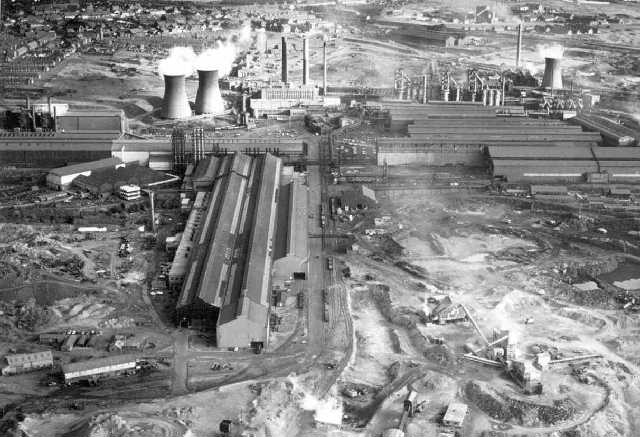When the Consett Steelworks closed in Sept 1980 the Sunday Times covered the story with the headline “Consett – The steel town that died“ and The Specials ska band had a hit single with the song Ghost Town and an accompanying video that seemed all too prophetic.
As in the aftermath of the passing of an elderly relative, the “house clear-out” began; £20 m of central Govt money was soon spent in a Reclamation programme that swept away every trace of 140 years of iron and steelmaking on a site of 900 acres that was once the largest in Europe . All except the disused rail network that had enabled the rise of the town as an Iron and Steel-making plant ; and the magnificent Howns Gill Viaduct , the epitome of a Victorian ambition to overcome any problem that the landscape threw up – a 150 ft high ravine was not going to stop the railway but it did ultimately bankrupt its creators in 1858. It was built in 18 months using 2.5 million firebricks from Crook with scaffolding manned by Navy riggers recently made redundant by the new ironclad steamships.
After Sept 1980 and for nearly the next ten years bulldozers and landscapers swept away the cooling towers, blast furnaces, rolling mills etc and created a new blank canvas of neat grassed fields , tree plantations and estate roads to offer to the next global company who might like to relocate and provide work for the 5,000 men and women who had worked for British Steel. An elderly local could point out his window and tell a child “When I was a bairn all these green fields were factories !

But Nissan, Siemens, Komatsu, Fujitsu and the like , never came , they all went elsewhere, nearer the coast, nearer the A1 and the transport infrastructure. However there were smaller local success stories – the disposable-nappy factory, Phileas Fogg, and a host of smaller service industrial units . The only multinationals to come were McDonalds and KFC to feed them, fast.
At the same time the very railway that had brought all the raw materials- coal , iron ore and limestone, to the steelworks and then taken away the manufactured steel was in turn reclaimed and turned into a cycle path and sculpture trail . No big commercial deal but it did attract national media interest and presented a new image of the town. However the ambition did not stop there , plans were drawn up to build a route from Coast to Coast , the link to the moors to the west of Consett was provided by the Viaduct , the scene of many tragic suicides in the aftermath of the works closure. The Sea to Sea route soon dubbed C2C would link the Northeast coast with industrial West Cumbria via a spectacular crossing of the N Pennines, an Area of Outstanding Natural Beauty marketed as England’s Last Wilderness. The two start or endpoints chosen were Whitehaven and Sunderland but were soon dismissed by one BBC Newcastle Radio presenter on air as unlikely tourist destinations, with Consett as the hub in the middle . However the national media was less cynical and soon perked up after C2C won a Global Award from the British Airways’ “Tourism for Tomorrow” competition and a half -hour slot on the Wish You Were Here TV programme. This was followed the next year by similar Global Award for Environmental Tourism from The Smithsonian at an Oscar-like ceremony in Los Angeles.
The opening year of the route, 1994, saw in excess of 15,000 people attempting the 140 mile route, and a whole new support industry of bunkhouses, B+Bs ,tearooms, cafes , transport providers , baggage handlers, cycle repairers began to flourish. 3 local farmers converted their byres and barns into tea rooms and bunkhouses, Morrisons moved the sandwich counter to the front door, the Grey Horse pub in Consett brewed a Coast to Coast Ale and there are 3 bike shops within a hundred yards of each other in the town centre. Souvenirs on sale include T shirts, caps. Coffee mugs, postcards, lapel badges and fridge magnets which all enable cyclists to celebrate and advertise their proud achievement. Most people take 2-3 days to complete it, some do it in one. One journalist aptly described it as the Wacky Races- lots of disparate groups of cyclists of all abilities pretending not to race each other , trying to outsmart each other but having a great time in the process.
The annual usage figure has remained consistent ever since with many thousands more doing shorter parts of the route. Estimated daily spend is about £40 per person. To this day it remains as the most popular long distance route in the UK and possibly Europe.
Not a week goes by without an article in the local press about a group of firemen, accountants, doctors, surveyors, Nissan car workers, etc doing the C2C for their nominated charity. Every group contains its own “newbie” who becomes the expert the following year and is organising his own trip.
Fundamentally the route has brought large numbers of people to Consett and NW Durham who would most probably not come otherwise , most are stunned by the scenery of wide open landscapes heather clad moorland and picturesque rural villages, all within a 20 minute drive from Tyneside. Most come back with partners and families for a more leisurely ride on our fantastic network of railpaths again and again.
Which all goes to show that Bikers mean Business. !





